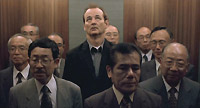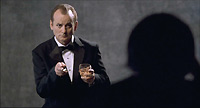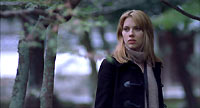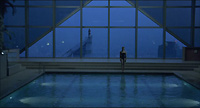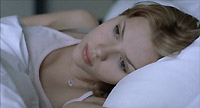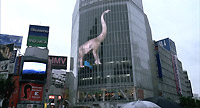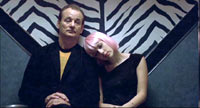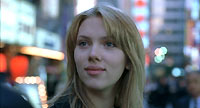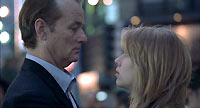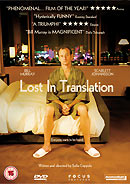 |
LOST IN TRANSLATIONRegion 2 (UK) Edition Director: Sofia CoppolaStarring: Scarlett Johansson, Bill Murray, Giovanni Ribisi, Anna FarisTHE FILM Sofia Coppola's critically-acclaimed film about two kindred spirits lost and culturally-bewildered in Japan, is a film with broad appeal, at least for those who have the patience to allow it to unfold in its own good time, and those who don't mind regular side-steps that serve character, not the plot. The film focuses on two individuals. Bill Murray plays a character that must surely be close to his own experiences and status as a star whose fame has dwindled, even if his talent has not. Murray's character, Bob Harris, is in Japan to endorse a brand of whisky. Aside from filming the cheesy commercial itself (replete with high-backed leather chair, roaring fire and dinner jacket), Harris is also obliged to appear on a bizarre MTV-style television show. His evenings are spent in the bar, or in his hotel room, on the phone to his emotionally and geographically-distant wife, Lydia. Scarlett Johansson plays Charlotte, recently-married but drifting aimlessly in the wake of her A-list celebrity photographer husband (Giovanni Ribisi, in a role apparently inspired by Coppola's former partner, Director Spike Jonze). She has plenty of free time, and spends it wandering the streets of Japan, taking in the scenery, and observing the local customs. As luck would have it, Charlotte and Bob are staying in the same hotel, and their paths begin to criss-cross. They soon bond, and begin a fleeting, intimate friendship that brings new focus to both their lives. Coppola's film begins as a wonderful study in isolation and alienation, perfectly capturing the experience of being lost in unfamiliar territory, with the added complication of jetlag. It initially touches on the regret and despair of its characters, and then becomes increasingly uplifting, eventually developing into a charming romance.
THE DVD Momentum Pictures' Region 2 DVD presents the film in 1.85:1 ratio, with anamorphic enhancement. The film was shot in less than a month, on a very tight budget, and it often shows. The cinematography is naturalistic, often shot Cinéma Vérité-style. Most of the film was filmed under what appears to be existing lighting conditions, sometimes resulting in a generally dull, low-contrast look. There are many dark scenes where shadows prevail, and here image is murky, with little definition. Well-lit scenes, however, are well-nuanced, and colours are occasionally vibrant. Under the right lighting conditions skin-tones look natural. The DVD transfer would seem to faithfully replicate the film's original theatrical appearance. The film has English HoH subtitles, but the bonus materials do not. There are a couple of English captions during the film, and these appear in their original format, and are not player-generated. The average bit-rate is 5.69Mb/s, rarely dipping below 4.0Mb/s. There are no signs of encoding artefacts, and very little evidence of artificial edge-enhancement. The disc offers a choice of two 5.1 audio tracks, one in Dolby Digital, the other in DTS. The DTS track (at 754kbps) has the edge on the Dolby Digital track (at 448kbps), with a slightly fuller tone during moments where separation and stereo imaging are more critical. The disc allows switching on the fly. The audio mix isn't elaborate, but there are a few scenes where the ambient sound is enveloping. The music is often working hard in the left and right channels, while keeping a discreet distance from the centre channel's dialogue, which is always distinct. Like the cinematography, the audio is generally naturalistic, with a minimum of post-production overdubbing. The disc has an animated menu screen offering four basic options, and it's very easy to navigate.
BONUS FEATURES The disc offers just about the perfect amount of bonus materials for a single-disc release. The only significant omission is a commentary track, which might have added a great deal of background information, and a sprinkling of useful facts that are otherwise missing. Adventurous viewers might, for example, be very disappointed that few of the film's locations are identified. The main supplement is "Lost" on Location, a disorganised thirty-minute fly-on-the-wall-style behind-the-scenes featurette, which gives the viewer access to various apparently random stages of the production process. It's full of wonderful moments, especially when Bill Murray is the focus of attention. Sadly there's precious little footage of Scarlett Johansson, and practically none where she's not actually performing for the film, which will surely frustrate the young star's many admirers. Matthew's Best Hit TV (5m) is the on-air feed from a scene where Bob visits an MTV-style show with a distressingly flamboyant host. Some of the footage is used in the film itself, when Bob watches it later that evening, but this is a more complete version. Kevin Shields' City Girl Music Video (3m) is pretty self-explanatory. In addition to making good use of the 1991 track Sometimes (from the album Loveless), the film features a number of new tracks by My Bloody Valentine's reclusive guitarist Kevin Shields, his first new material in twelve years. City Girl bookends the film, appearing under the opening title sequence (superimposed over a memorable shot of Scarlett Johansson's backside), and during the end credits. Shields' contributions - and City Girl in particular - were rewarded by a nomination for BAFTA's Anthony Asquith Award for Achievement in Film Music. The video features clips from the movie. There are five Deleted Scenes, presented in good-quality, unfinished offline format, totalling about ten minutes: More Aqua Aerobics (Bob horsing around at the swimming pool), Charlotte With Robots (Charlotte encounters some knee-high robots), Kelly's Press Conference (a longer version of the press conference to promote her film, Midnight Velocity), Morning After Karaoke (Charlotte wakes up, rings Bob, and invites him for breakfast) and Bob in Hospital Waiting Room (a longer version of a scene where Bob chats to an elderly Japanese man). None of the scenes add very much, but fans will definitely get a kick out of them. A Conversation With Bill Murray and Sofia Coppola is a rather awkward ten-minute interview, in which Sofia and Bill cover a few basic facts and share a few unusual experiences. There's clearly a terrific rapport between the Director and her leading man, but the presence of the camera is obviously an unwelcome intrusion.
SUMMARY The film is charming, but won't be to everyone's taste. The disc has a very acceptable transfer, with a very nice multi-channel audio mix. It seems unlikely that the disc's transfer could be improved upon. The bonus materials are worthwhile, although fans of Ms Johansson will be disappointed. A commentary track might have made a big difference. The Region 2 release seems to be practically identical to the Region 1 version. |


